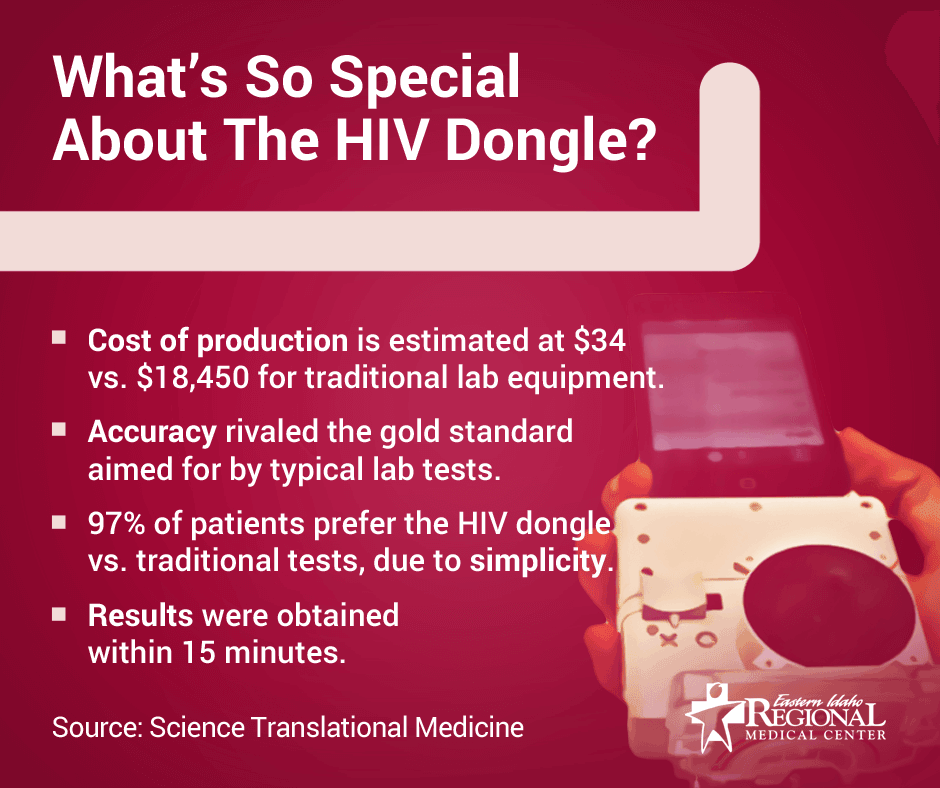So, you thought your smartphone could do everything? As it turns out, the word “everything” gets redefined every day in the 21st century.
And in the case of healthcare, technological advances are slowly transferring what was once only possible in a lab straight to your phone.
Tests for deadly diseases no longer have to be done with clunky and expensive lab equipment. Learn how inexpensive and portable technology can now do the work in a fraction of the time.
But Does It Work?
A team of researchers at Columbia University developed a low-cost smartphone accessory that can test for syphilis and HIV. The unit can be held in one hand and provide a result within 15 minutes, according to Columbia Engineering.
It's understandable for such a claim to be met with skepticism. And while more tests will be performed, early results are strong.

What's so Special About the HIV Dongle
- Cost of production is estimated at $34 vs $18,450 for traditional lab equipment.
- Accuracy rivaled the gold standard aimed for by typical lab test.
- 97% of patients prefer the HIV Dongle vs. traditional test, due to simplicity.
- Results were obtained within 15 minutes
SOURCE: Science Translational Medicine
What Are The Implications?
The technology's accessibility makes it even more exciting. Low-income, rural, and impoverished areas with limited access to state-of-the-art technology would now gain access.
Although these communities may not have consistent electric power supplies, the dongle overcomes that.
It draws power directly from the smartphone and connects via the audio input. This is key. Because these audio jacks are standardized across all phones, it has almost universal applicability.
This also makes it easy to use. It was so simple that healthcare workers were able to hit the ground running after just 30 minutes of training.
A device like this has the power for large-scale implementation in regions that not only cannot afford the standard equipment, but are also in need of HIV testing.
A DIY Bio History Lesson
The first major website for DIY Bio, diybio.org, was established in January 2008 in Boston. The site has since spawned more than 5,000 discussion topics.
It received further endorsement from Bill Gates a couple of years later.
“If you want to change the world in some big way, that's where you should start”biological molecules,” says Bill Gates in a 2010 Wired Magazine article.
People heeded this advice. The “Do-It-Yourself Biology” (DIY Bio) movement has gone global, according to a September 2013 article in the research journal Synthetic and Systems Biology.
What About DIY Biology Tech Developed By Non-Professionals?
Regional biology-oriented community labs have been established in New York (Genspace), California (BioCurious), Paris (La Paillasse), and in Manchester, UK (MadLab).
While these are the most well-known labs, more than 500 such hackerspaces exist worldwide. Hackerspaces are spots for non-professionals to explore their interests in biology”and to work toward their common goal of improving your quality of life.
But can they do it as well as standard lab testing? Not yet. These hackerspaces have hurdles to overcome before they are able to replicate the results achieved in a professional laboratory, according to a March 2014 article in the research journal Bioengineered.
Although fundraising tools like Kickstarter have made money less of an issue, biosafety and security are the primary concerns. BioCurious and La Paillasse are leading the way by operating their hackerspaces with the proper transparency and regulation.
More Applications
The early success seen by the HIV dongle has encouraging implications for other similar devices. Amplino is one such invention.
Amplino is a portable diagnostic system capable of detecting malaria within 40 minutes with a single blood drop, reports Bioengineered.
Just like the HIV dongle, it is able to function in low-income areas where malaria is rampant.
These kinds of collaborative organizations ensure an exciting future for DIY Bio. Technologies such as the HIV dongle and Amplino are sure to inspire future innovation for application in the areas that need it most.
Also read: Sometimes, traditional labs are best. Read about EIRMC's new cath lab.
$webqFacilityNumber
Need a Physician?